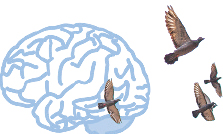TO THE STUDENT
xlviii
Learning from Discovering Psychology
Welcome to psychology! Our names are Sandy Hockenbury, Susan Nolan, and Don Hockenbury, and we’re the authors of your textbook. Every semester, we teach several sections of introductory psychology. We wrote this text to help you succeed in the class you are taking. Every aspect of this book has been carefully designed to help you get the most out of your introductory psychology course. Before you begin reading, you will find it well worth your time to take a few minutes to familiarize yourself with the special features and learning aids in this book.
Learning Aids in the Text
KEY THEME
You can enhance your chances for success in psychology by using the learning aids that have been built in to this textbook.
KEY QUESTIONS
What are the functions of the Prologue, “Myth or Science?” questions, Advance Organizers, Key Terms, Key People, and Concept Maps?
What are the functions of the different types of boxes in this text, and why should you read them?
Where can you go to access a virtual study guide at any time of the day or night, and what study aids are provided?

First, read and think about the “Myth or Science?” questions at the beginning of each chapter. These questions reflect common ideas about some of the topics we’ll cover. How many of these statements have you heard before? In the course of reading the chapter you’ll find out which statements are popular myths—
Next, take a look at the Chapter Outline at the beginning of each chapter. The Chapter Outline provides an overview of the main topics that will be covered in the chapter. You might also want to flip through the chapter and browse a bit so you have an idea of what’s to come.
Then, read the chapter Prologue. The Prologues are true stories about real people. Some of the stories are humorous, some dramatic. We think you will enjoy this special feature, but it will also help you to understand the material in the chapter that follows and why the topics are important and relevant to your life. In each chapter, we return to the people and stories introduced in the Prologue to illustrate important themes and concepts.
As you begin reading the chapter, you will notice several special elements. Major Sections are easy to identify because the heading is in blue type. The beginning of each major section also includes an Advance Organizer—a short section preview that looks like the one above.
The Key Theme provides you with a preview of the material in the section to come. The Key Questions will help you focus on some of the most important material in the section. Keep the questions in mind as you read the section. They will help you identify important points in the chapter. After you finish reading each section, look again at the Advance Organizer. Make sure that you can confidently answer each question before you go on to the next section. If you want to maximize your understanding of the material, write out the answer to each question. You can also use the questions in the Advance Organizer to aid you in taking notes or in outlining chapter sections, both of which are effective study strategies.
xlix


Think you’re good at paying attention? Try Video Activity: Attention.
Notice that some terms in the chapter are printed in boldface, or darker, type. Some of these key terms may already be familiar to you, but most will be new. The darker type signals that the term has a specialized meaning in psychology. Each key term is formally defined within a sentence or two of being introduced. The key terms are also defined in the margins, usually on the page on which they appear in the text. Some key terms include a pronunciation guide to help you say the word correctly.
Occasionally, we print words in italic type to signal either that they are boldfaced terms in another chapter or that they are specialized terms in psychology.
Certain names also appear in boldface type. These are the key people—the researchers or theorists who are especially important within a given area of psychological study. Typically, key people are the psychologists or other researchers whose names your instructor will expect you to know.
You’ll also notice notations at the end of major sections inviting you to  Test your understanding with
Test your understanding with  . This notation signals that the material you have just finished reading is covered by a comprehensive quiz in Launch-
. This notation signals that the material you have just finished reading is covered by a comprehensive quiz in Launch-

Think Like a SCIENTIST
Can you learn to tell when someone is lying? Go to LaunchPad: Resources to Think Like a Scientist about Lie Detection.

In the margins of every chapter, you will find callouts directing you to LaunchPad activities. Some of these LaunchPad activities expand upon topics introduced in the text, while others will help you review and better comprehend the text’s information. Many of the activities incorporate video footage or simulations, but all of them were chosen for their relevance to the chapter material.
Also in LaunchPad are the Think Like a Scientist Immersive Learning Activities. These activities were created by your authors to help you develop your scientific thinking skills. This special feature provides an interactive, fun, and interesting activity to apply what you’ve learned to a new topic or claim. Whenever you see a Think Like a Scientist callout in the margin of your textbook, check out the activity to explore questions like “Can you learn to tell when someone is lying?” and “Do you have psychic powers?”
Reviewing for Examinations
The Chapter Review at the end of each chapter includes several elements to help you review what you have learned. All the chapter’s key people and key terms are listed, along with the pages on which they appear and are defined. The key terms are also boldfaced in the chapter summary so you can see their use in context. You can check your knowledge of the key people by describing in your own words why each scientist is important. You will also want to define each key term in your own words, then compare your definition to information on the page where it is discussed. The visual Concept Maps at the end of the chapter give you a hierarchical layout showing how themes, concepts, and facts are related to one another. The photos in each Concept Map should provide additional visual cues to help you consolidate your memory of important chapter information. Use the visual Concept Maps to review the information in each section.
Special Features in the Text
Each chapter in Discovering Psychology has several boxes that focus on different kinds of topics. Take the time to read the boxes because they are an integral part of each chapter. They also present important information that you may be expected to know for class discussion or tests. There are five types of boxes:
Critical Thinking boxes ask you to stretch your mind a bit by presenting issues that are provocative or controversial. They will help you actively question the implications of the material that you are learning.
l
Science Versus Pseudoscience boxes examine the evidence for various popular pseudosciences—
from subliminal persuasion to Baby Einstein videos and graphology. These discussions will help teach you how to think scientifically and to critically evaluate claims in many different fields— not just psychology. Culture and Human Behavior boxes are another special feature of this text. Many students are unaware of the importance of cross-
cultural research in contemporary psychology. These boxes highlight cultural differences in thinking and behavior. They will also sensitize you to the ways in which people’s behavior, including your own, has been influenced by cultural factors. In Focus boxes present interesting information or research. Think of them as sidebar discussions. They deal with topics as diverse as human pheromones, whether animals dream, and why snakes and spiders give so many people the creeps.
Focus on Neuroscience sections provide clear explanations of intriguing studies that use brain-
imaging techniques to study psychological processes. Among the topics that are highlighted: schizophrenic hallucinations, mental images, drug addiction, and romantic love and the brain.
The Psych for Your Life section at the end of each chapter provides specific suggestions to help apply chapter information to help you deal with real-
Especially important is the Psych for Your Life section at the end of Chapter 1, which provides a list of research-
There are two special appendices at the back of the text. The Statistics: Understanding Data appendix discusses how psychologists use statistics to summarize and draw conclusions from the data they have gathered. The Industrial/Organizational Psychology appendix describes the branch of psychology that studies human behavior in the workplace. Your instructor may assign one or both of these appendices, or you may want to read them on your own.
At the back of this text is a Glossary containing the definitions for all key terms in the book and the pages on which they are discussed in more detail. Also, interested students can look up the specific studies we cite in the References sections.
LAUNCHPAD FOR DISCOVERING PSYCHOLOGY, SEVENTH EDITION
Get the most out of Discovering Psychology, Seventh Edition, with LaunchPad, which combines an interactive e-
Fully Interactive e-
Book: The LaunchPad e- Book for Discovering Psychology, Seventh Edition, comes with powerful study tools. You can search, highlight, and bookmark, making it easier to study. Multimedia Content: Access videos, simulations, tutorials, and Think Like a Scientist activities that help you understand and master the material.
LearningCurve: These game-
like quizzes adapt to what you already know and help you master the concepts you need to learn.
li
To learn more about LaunchPad for Discovering Psychology, Seventh Edition, or to request access, go to launchpadworks.com.
That’s it! We hope you enjoy reading and learning from the seventh edition of Discovering Psychology. If you want to share your thoughts or suggestions for the next edition of this book, you can write to us at the following address:
Sandy Hockenbury, Susan Nolan, and Don Hockenbury
c/o Worth Publishers
One New York Plaza
Suite 4500
New York, NY 10004-
Or you can contact us at our e-
Hockenbury.Psychology@gmail.com
Have a great semester!